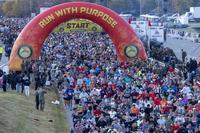As humans, we struggle to maintain balance in extreme temperatures on both ends of the thermometer, and we all have our physical limits. For military members, these are potentially dangerous situations, as they may have to live and work in one extreme or the other, in both training and real-world operations.
Our bodies develop an intricate thermoregulation system to keep us alive; humans have different tolerance levels in overcoming the impacts of extreme hot and cold. The body is a remarkable machine, constantly adapting to the environment with a built-in thermostat located in the hypothalamus area of the brain. This thermostat maintains our core temperature whenever we're exposed. In hot conditions, we sweat and our blood vessels dilate to release heat. In cold conditions, they constrict to conserve heat, and we may shiver to generate warmth.
Like all machines, running out of fuel or coolant (in this case, water) can cause the body to suffer the dangerous effects of extremes at a much quicker rate. From heat cramps and heatstroke in high temperatures to frostbite and hypothermia in the cold, understanding these dangers is crucial for our well-being. Temperature variations can be reversible with constant awareness, behavioral changes and proper responses. If not regulated, extreme temperatures can end your training or mission capability and ultimately lead to organ failure, coma and death.
Below are some tips to help you manage when working in these environments for long periods of time.
Preparing for Extreme Temperatures
Can you prepare for the cold and heat? Absolutely. A popular trend now is taking cold showers or ice baths or sitting in saunas. These are ways to help the body gain "reps" and help you better understand personal limits in extreme temperatures. However, these practices come with the same warnings of Mother Nature's hot and cold extremes, so any self-inflicted cold or hot practices must be done with similar precautions.
Here is some basic preparation advice on heat and cold temperature regulation practices to keep you safe and healthy, whether working in the winter cold or summer heat.
Tips for Colder Temperatures
1. Dress in multiple layers of clothing, using wicking material against the skin and thicker and fluffier wool, down or fleece garments to help keep warm and dry above that first layer. Use an outer layer of hard- or soft-shell gear when it is raining, windy or snowing. Hard shells are waterproof, while soft shells are water resistant.
2. Stay hydrated with warm drinks and avoid caffeine or alcohol. Drink hot cocoa instead of hot tea or coffee.
3. Limit time spent outside in below-freezing temperatures. Make frequent trips to warmer areas to help with extremity warming (hands, feet and face). Your core temperature will likely be fine in limited exposure, but your extremities will freeze before your core does.
4. If working in an outdoor area for long periods, have heaters available, if possible.
5. Keep an indoor area warm so you can warm up occasionally during and after hours of working in the cold. Having a place where you can warm up quickly may save your life: Do not neglect this backup plan.
Remember that cold weather can increase heart rate. Heart attacks occur every year while people work outside in the cold. Blood vessels constrict when the body's natural heating processes begin and can cause heart attacks or stroke, especially in deconditioned people. Often just shoveling snow on the sidewalks can be enough to trigger cardiac emergencies. Even when healthy, ensure you warm up and stretch before working outside, pace yourself and avoid lifting too heavy or working to exhaustion.
Tips for Hotter Temperatures (Arid or Humid)
1. Dress in light-colored and breathable fabric. Avoid dark colors if working in the sun all day and wear a "bucket" hat to create shade on your face and neck. Check out this example.
2. Do not forget sunscreen and find ways to make shade with tents, sheets, tarps, etc.
3. Stay hydrated. Carry cool water and electrolytes with you, no matter where you go.
4. Avoid outdoor activities during peak heat hours, if possible.
5. Half of your fatigue may be body heat, so cool off in water, shade or indoor, air-conditioned areas regularly.
6. Keep an indoor area cool so you can cool down occasionally during and after hours of working in the heat. Having a place where you can quickly cool down, like an indoor, air-conditioned area, shade or water source, may save your life: Do not neglect this backup plan. Keep water and electrolytes readily available in this cooling area.
Remember, your health matters; take the necessary steps to protect yourself from extreme temperatures. Get informed and take charge of your well-being and discover the science behind how your body responds to extreme heat. This study on Arctic weather conditions and military personnel shows you the wide range of heat and cold that can occur in military training and work environments.
Stew Smith is a former Navy SEAL and fitness author certified as a Strength and Conditioning Specialist (CSCS) with the National Strength and Conditioning Association. Visit his Fitness eBook store if you're looking to start a workout program to create a healthy lifestyle. Send your fitness questions to stew@stewsmith.com.
Want to Learn More About Military Life?
Whether you're thinking of joining the military, looking for fitness and basic training tips, or keeping up with military life and benefits, Military.com has you covered. Subscribe to Military.com to have military news, updates and resources delivered directly to your inbox.


















